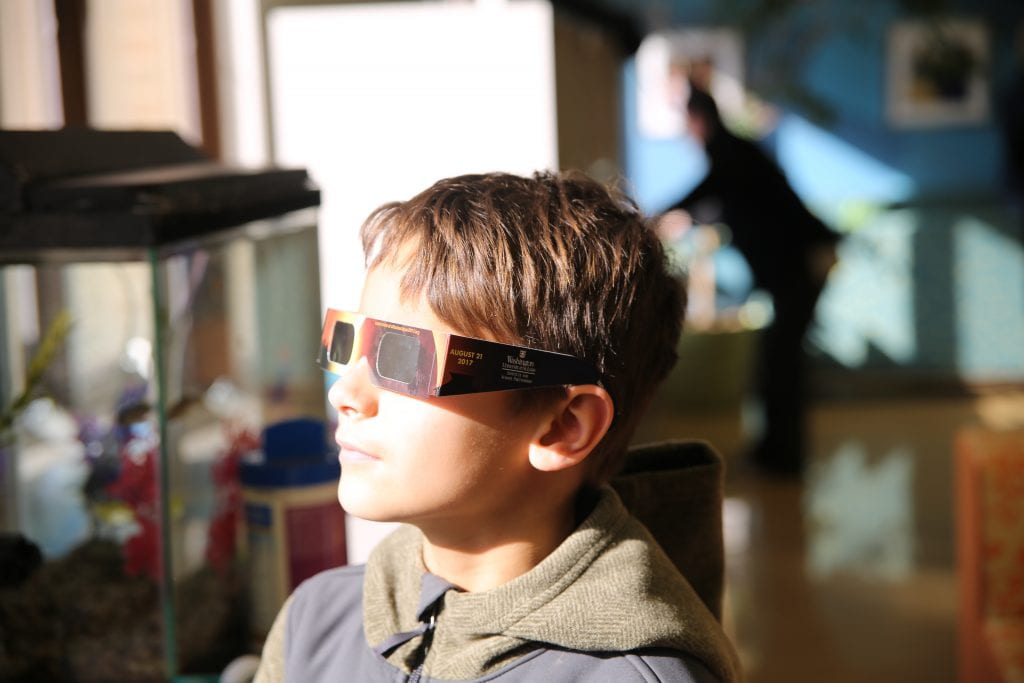St. Louis and the surrounding area is abuzz with excitement about the upcoming total solar eclipse, as well it should be. This very unique experience is not to be missed, if possible. There are online resources available for information and activities, such as from the St. Louis Astronomical Society and the St. Louis Eclipse 2017 Task Force.
The safety considerations concerning eclipse safety glasses have been well publicized, but how and what to do with our youngest learners needs a little more conversation. As any parent of a preschooler knows, getting your child to put on or keep on a hat or gloves can be a major challenge. This should be kept in mind as we consider options for using solar eclipse glasses with young children.
If you decide to have your child wear the glasses and look directly at the sun, here are a few suggestions.
- Practice, practice, practice. Have your child put them on and take them carefully off several times. Emphasize that these are not toys, but a very important scientific device that will let them see something special. Do not let them twist or bend them as this could affect their safety ability. The glasses are only for looking at the sun, standing still, with a parent or responsible adult. (The glasses are very, very dark and objects such as curbs or obstacles on the ground will not be visible.)
- Start indoors and have them look at a lamp with the glasses on. They will not be able to see anything! These glasses filter out most of the light! Then try outside, on a sunny day, preferably with enough wind to watch clouds go by the sun. Remember not to let your child run or walk while they have the glasses on.
- On the day of the eclipse, either choose to go outside right before the event, (1:00pm-1:30 pm, CT) and give them their glasses. If you are outside playing as the eclipse is happening, keep careful attention that they don’t stare at the sun while they are playing. We don’t often stare at the sun because it makes us squint and it hurts our eyes. But once the moon starts to move in front of the sun (eclipse), the UV rays (which you feel) start to lessen, but major radiation intensity remains.
An alternative to having your child look at the sun during the eclipse is to direct their attention to shadows below them. Children and shadows go together like peanut butter and jelly. Shadows fascinate them. Here are a few suggested shadow activities.
- Let your child play with a small flashlight inside. Just remind them not to shine it into anybody’s eyes, not even their own.
- Point out the shadows they make with the flashlight. Make some with your child. Show them how to move the light to make shadows get bigger (moving either the light or the object blocking the light closer).
- Take them outside at different times on a sunny day and have them find their shadows. Ask them if the shadow was bigger or smaller than the last time they went out.
- On the day of the eclipse, take sifters, colanders or a piece of cardboard with a hole poked in the middle of it outside. Have your child look at the different shadows those make. During the eclipse you can follow the path of the moon across the sun by watching the shadow it makes on the sidewalk under the colander or cardboard.
- The hole in the cardboard is a very rudimentary form of a pinhole camera. Here is a way to make one for the eclipse from NASA that uses cardboard and aluminum foil.
Even though careful safety precautions must be taken, it is possible for your young child to observe this amazing phenomenon and it should not be missed!
August 2017 | by, Skyler Wiseman, ISP preK-5 curriculum & instructional specialist; reviewer for NSTA magazine, Science and Children.
